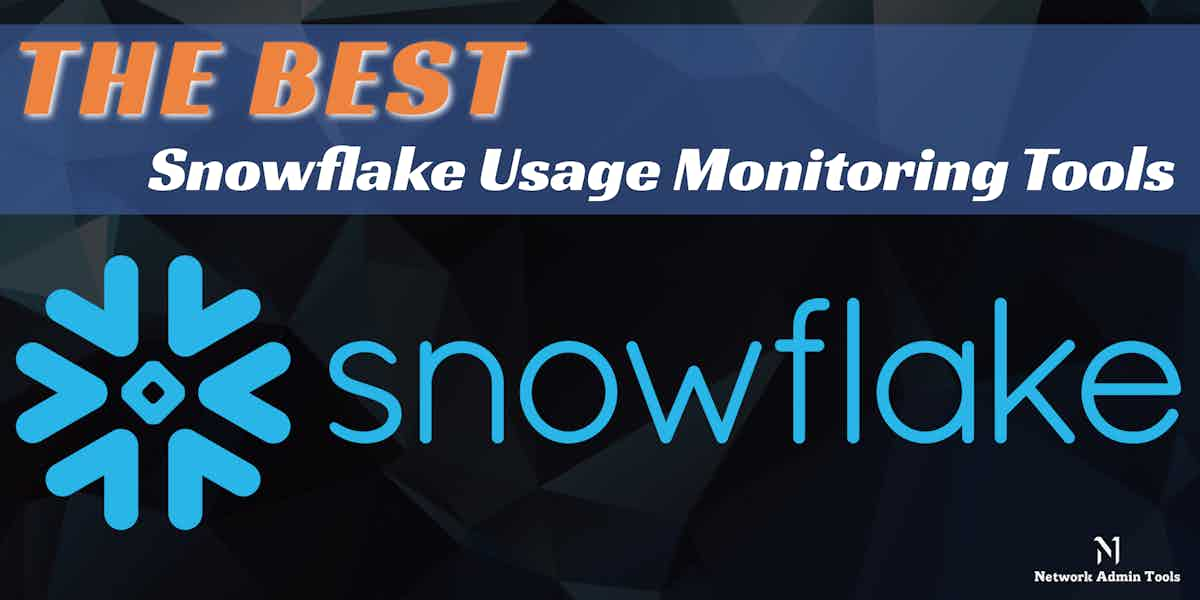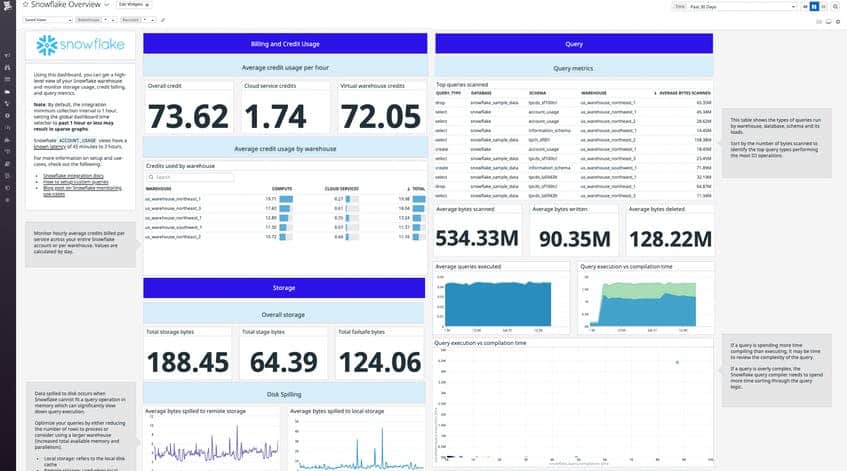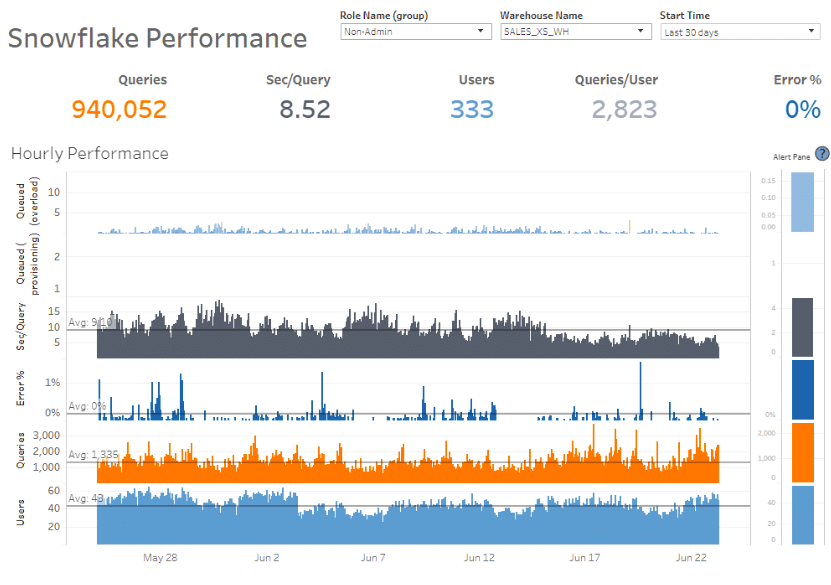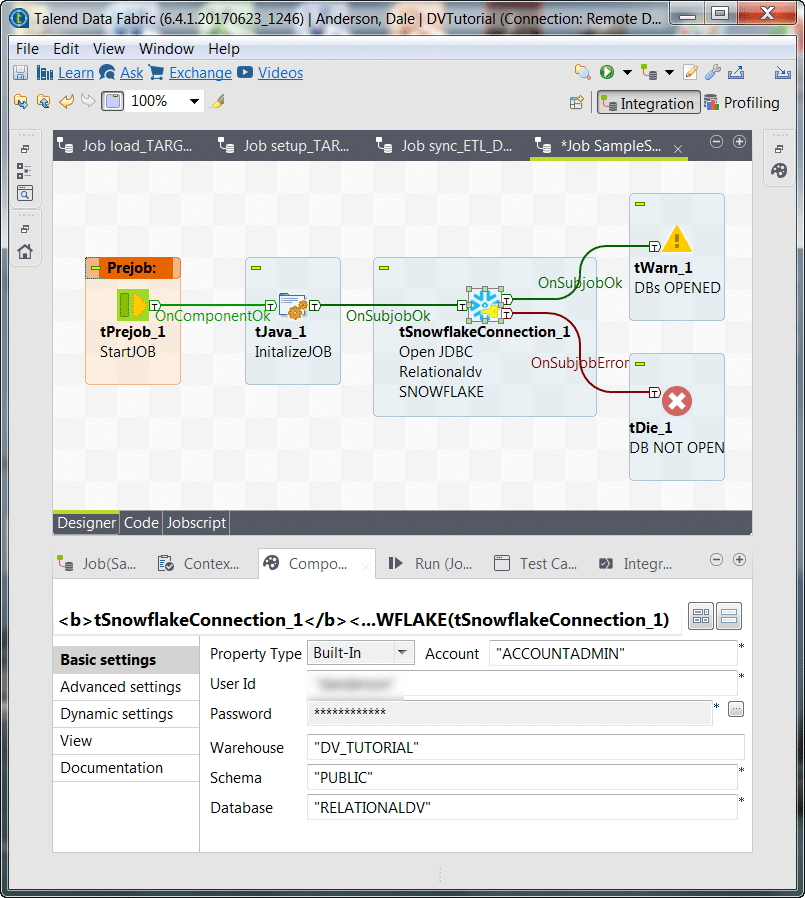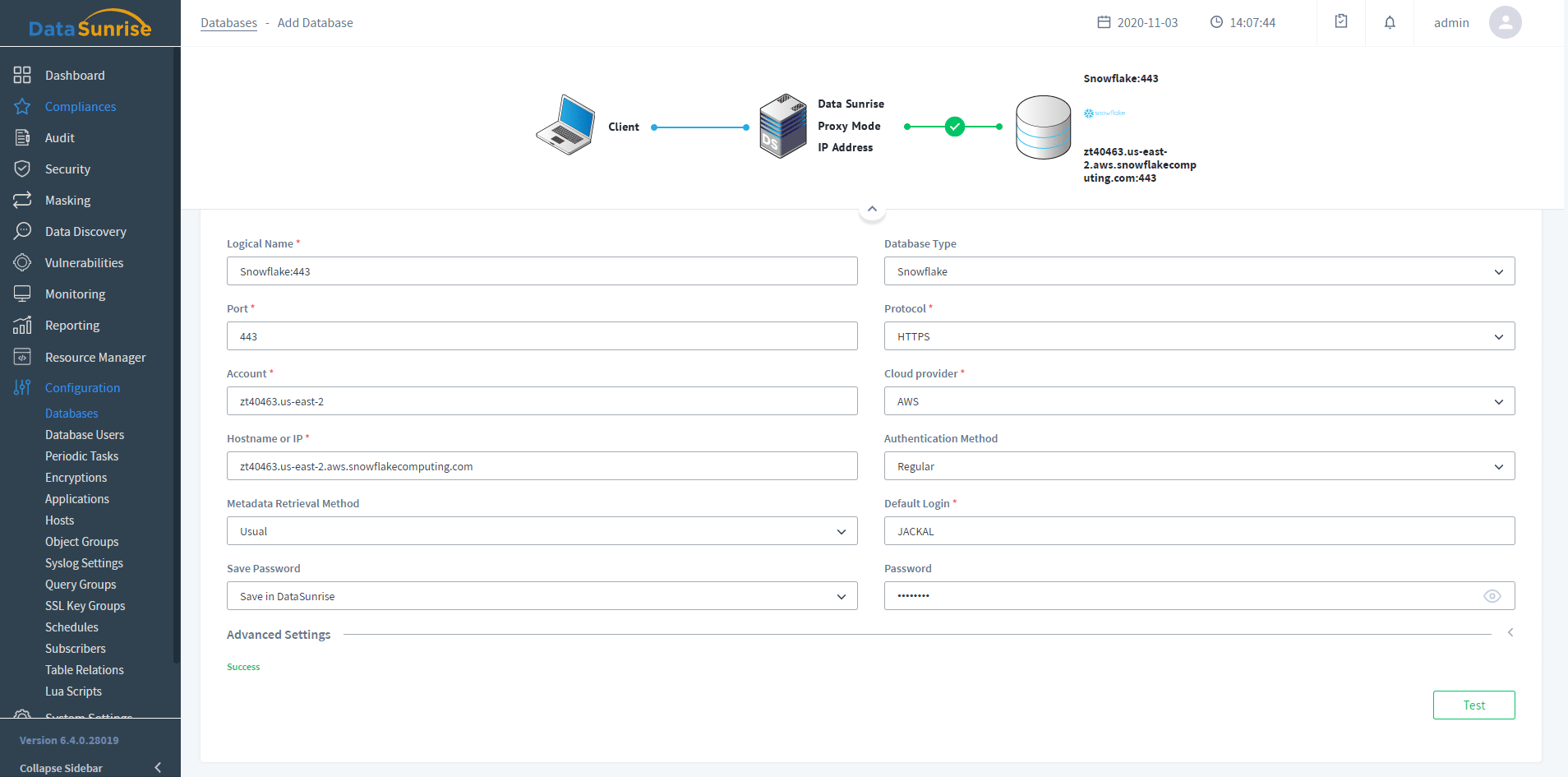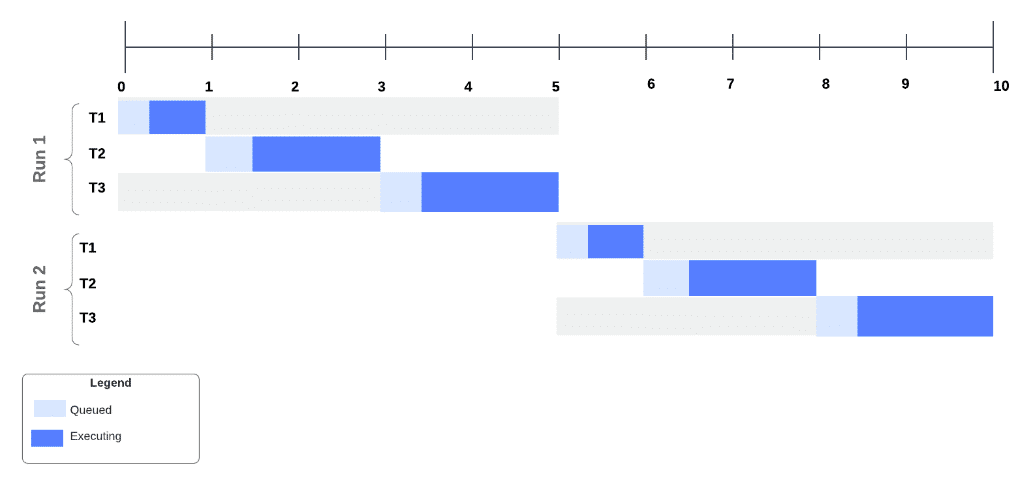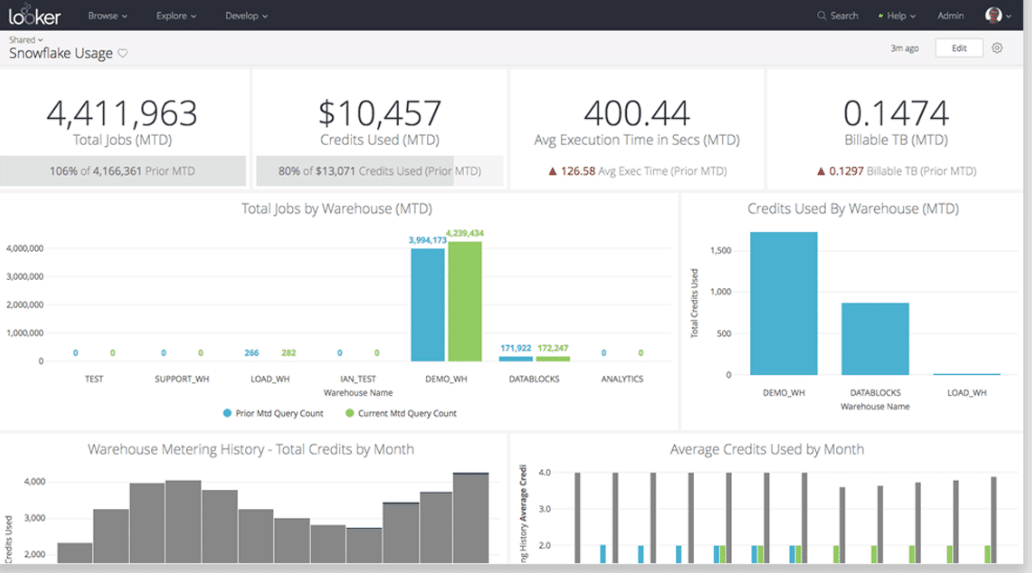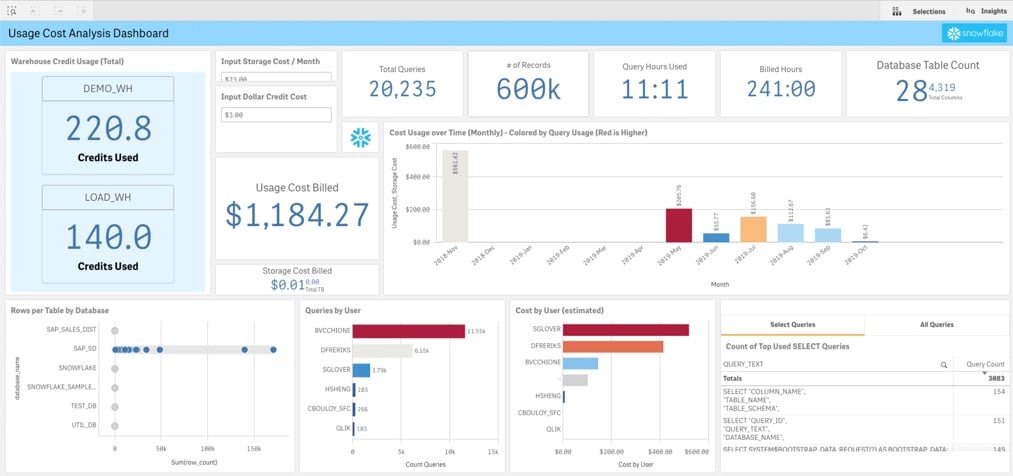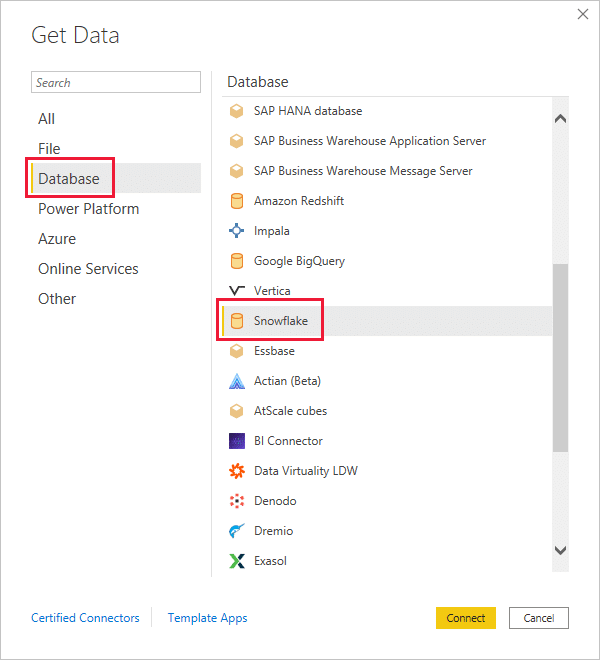Snowflake’s Data Cloud is one of the most popular cloud-based data platforms that provide a wide range of solutions for your businesses to work efficiently. It enables faster data processing, integration, and analytical solutions. It is not built on any ‘big data’ software platform but a combination of a new SQL query engine designed for use in the cloud. Unlike before, businesses had to spend large amounts purchasing a data warehouse. However, with Snowflakes being a cloud-based platform, the requirement to buy a separate data warehouse is no longer a necessity. It is no longer required to install, configure, or manage separate hardware or software for Snowflake. Its architecture and data-sharing capabilities are designed to make it easy for organizations to share data faster and more securely.
If your organization is looking for a tool that helps perform database analytics tasks faster, look no further. Snowflake’s data cloud platform is one of the best solutions and charges only on your usage periods. Get insightful data for your business using some popular Snowflake analytics tools. In this post, we have highlighted the top Snowflake analytics tools preferred and used by most organizations.
Here is our list of the best Snowflake usage monitoring tools and software:
- Datadog Snowflake Monitor One of the powerful tools that can be integrated with Snowflake and provide more visibility and usage monitoring. It helps you to track the performance of your service and apps from different sources and turns them into insightful data.
- Tableau Snowflake Monitoring A very popular analytics platform used to track Snowflake virtual warehouses usage data. It provides user-friendly dashboards and helps you to reduce computing costs.
- New Relic Snowflake Monitoring One of the best software analytics solutions that offers very useful features including production monitoring, real-Ttme analytics, cloud migration, application development, alerting options, etc.
- Talend Relic Snowflake Monitoring Designed for an enterprise-grade environment that allows quick and seamless Snowflake integration. It allows you to assess reliable data via queried metrics, perform error checks, and discover real-time issues.
- DataSunrise Security Suite A real-time monitoring tool that tracks traffic and queries made to all Snowflake-integrated databases. It is one of the best monitoring tools for discovering fraudulent insider activities and hacker attacks.
- Snowflake Standalone An open-source and leading data processing analytical tool that offers unique solutions without requiring any third-party tool like other integrations to monitor usage, cost, performance, and data security.
- Looker Snowflake Monitoring Tool A data analytics solution specially designed for small and large companies. It allows users to customize and generate interactive visualizations using graphs and charts.
- Qlik Business A data analytics platform that offers integration features and a user-friendly dashboard. You can try the free trial or opt for business or enterprise versions as per the need.
- Microsoft PowerBI Tool Simple BI tool that can be integrated with Snowflake to compute costs, monitor usage, and display user data. It is a cloud-based tool and helps transform raw data into insightful information using various data visualization tools.
What should you look for in Snowflake usage monitoring tools?
With so many analytics tools available on the market, it gets difficult for businesses to select the best one for their data warehouse. An important part of any analytical tool is to check errors, faults, traffic usage, and issue response. Apart from these, there are more factors that one must consider before making a critical decision. Choosing the appropriate data warehouse analytical tool can make or break data pipeline effectiveness.
Follow some of the factors one must consider when choosing an analytical or usage monitoring tool for Snowflake:
- Provides full integration support to different data warehouse solutions, including Snowflake.
- Comprises a robust feature that helps generate complex reports and real-time visualizations.
- Easy to implement or use.
- Support team collaboration for smooth operations.
- Training cost, license, documentation, and other usage costs.
- Quality of community support and customer service.
- Support real-time data migration.
- Live monitoring features.
The Best Tools for Snowflake Usage Monitoring
Check out some of the best analytics tools available in the market that can be integrated with Snowflake and meet business requirements. However, it is a challenging task, yet some of the below-listed tools can be advantageous for your business. Follow the comprehensive list of the best Snowflake analytics tools and monitor data usage.
Methodology for Selecting the Best Tools for Snowflake Usage Monitoring
Businesses find it challenging to choose the appropriate analytics tool for their data warehouse because there are so many of them on the market. Here we have listed a few methodologies you must consider when finding an appropriate tool for Snowflake usage monitoring:
- Full integration support for various data warehouse technologies
- Generates complex reports and visualizations in real time
- Support team collaborations for smooth operations
- Community support and customer services
- Live monitoring features
1. Datadog
Datadog can be integrated with Snowflake’s architecture to provide more visibility and usage monitoring. By integrating with Snowflake, users can implement features of both solutions, understand usage by user, role, etc., and calculate cost on the basis of active usage time.
Key Features:
- Complete access to Snowflake’s architecture
- Provides a single, durable storage system for all of your data that can be staged and loaded in different ways
- Offers a seamless workflow, regardless of location
- Helps detect misconfigurations and track warehouse performance
- Offers full visibility into servers and applications
Why do we recommend it?
Datadog is highly recommended for its comprehensive integration with Snowflake, providing valuable insights into usage, cost analysis, and performance. Its global accessibility and advanced features like misconfiguration detection make it ideal for enterprise-level environments.
It is a great choice if you are looking for a tool that helps monitor fluctuations in storage usage. The popular tool helps track the performance of your service and apps from different sources and turns them into insightful data. It provides a seamless workflow regardless of geographical position. Furthermore, Datadog integration allows computing credit consumption, detecting misconfigurations, and monitoring warehouse performance.
Who is it recommended for?
This integration is tailored for businesses utilizing Snowflake for data storage, seeking enhanced visibility, usage monitoring, and cost optimization. Datadog is particularly beneficial for organizations aiming to streamline data analysis, enhance security, and receive timely alerts for any issues in their Snowflake environment.
Pros:
- Full visibility over services, apps, and tools
- Streamlines data analysis
- Supports configuration of the data filtration setup
- Provides notifications or alerts on noticing any issue
- Optimizes the storage usage
- Detects security threats
- Performs cost analysis with projections
Cons:
- Free version lacks most of the vital features
You can try a 14-day free trial and handle up to five hosts. However, the free version does not support advanced features like forecasting. Also, for the Snowflake integration, you must have a Datadog agent with an Infrastructure solution.
2. Tableau
Tableau is another analytics platform that helps track Snowflake virtual warehouse usage data. It comprises some intuitive products that make data analysis fast and easy for users. You can also create comprehensive dashboards using the tool that aids in computing costs and monitoring performance. It helps convert raw data into valuable insights by making requests to the cloud, spreadsheets, relational databases, and more for statistical data. Then it allows you to categorize and correlate the data into a comprehensive analytical report.
Key Features:
- User-friendly tools that enable quick and simple data analysis for users
- Assists in transforming raw data into insightful reports by sending requests to the cloud, RDBMS, and other statistical data
- Runs active online forums and communities for discussions and queries
- Offers seamless integration with other tools
- Supports user-based filters and alert functionalities
Why do we recommend it?
Tableau’s integration with Snowflake is recommended for its robust analytics and user-friendly features that simplify data analysis and transformation. It excels in creating insightful reports and dashboards, making it a vital tool for monitoring Snowflake virtual warehouse usage.
It comprises remarkable visualization capabilities, supports thriving community and forum platforms for discussions, provides high performance, and is an easy-to-use usage monitoring tool. If you are looking for a Snowflake usage monitoring tool that can handle a large amount of data without affecting the performance, Tableau is the right choice. Also, it is mobile friendly and supports seamless integration, user-based filters, and alerting features.
Who is it recommended for?
Tableau is best suited for organizations that need to track and optimize their Snowflake virtual warehouse usage. It’s especially beneficial for users requiring data analysis, visualization, or alerting features, providing a comprehensive and accessible platform.
Pros:
- Supports seamless integration
- Provides notification and alerts if the cost values exceed the prediction
- Supports user-based filters
- Easy to implement
- Mobile friendly and offers high performance
- Thriving community and forum platform for users
Cons:
- After-sales support services are poor
- Possible security issues
- Expensive and inflexible pricing
- BI Capabilities are poor
Try a 14-day free trial or purchase a license depending on the purpose. It supports three license options; Creator (connect data and publish custom dashboards) for $70 per month, Explorer (make changes to the existing dashboard) for $42 per month, and Viewer (supports read-only access to the data) for $15 per month.
3. New Relic
Founded in 2008, New Relic has grown into one of the largest players in the industry. It provides detailed insights to users about their software performance, and helps mobile developers in analyzing and improving performance. Also, the application performance monitoring capabilities help users receive an in-depth report and cost tracking.
Key Features:
- Identifies warehouse performance issues and fixes them in real-time
- Keeps track of every metric, event, trace, or log at a single location for quick access
- Provides accurate real-time page load times
- Assists in server-side bug fixing
- Provides detailed insights about software performance after collecting and converting data
Why do we recommend it?
New Relic is recommended for its comprehensive software performance monitoring and analytics, including Snowflake monitoring. Its real-time warehouse performance issue identification and centralization of metrics and logs make it an excellent choice for optimizing Snowflake usage.
New Relic is one of the best software analytics solutions for businesses that want to analyze and develop relevant data from applications. The tool supports various features like production monitoring, real-time analytics, cloud migration, application development, alerting options, etc., that help deliver software with good performance and speed. Also, it emphasizes writing codes rather than troubleshooting them.
Who is it recommended for?
New Relic’s Snowflake monitoring capabilities are recommended for businesses of all sizes that want to analyze and improve their Snowflake usage and software performance. With flexible pricing options and a focus on providing stable and high-performance solutions, New Relic is suitable for organizations looking to optimize their software and database performance efficiently.
Pros:
- Stores all the metrics, events, traces & logs at a central place
- Supports alerting option
- Variable pricing model
- Trusted mobile app monitoring tool with the ability to collect, analyze, and convert data into useful insights
- Focuses on writing rather than troubleshooting
- Provides stability and high-performance
- Helps debug the server-side
- Provides exact real-user page load times
- Helps detect any warehouse performance issue
Cons:
- Interface could be a little tricky for users
- Web page loading data is not provided in detail
- Users need to constantly lower the threshold to improve the site
- Many sections require you to upgrade to a premium account
Enjoy the flexible pricing with New Relic. Regardless of your pricing plan, the Snowflake usage monitoring tool helps track costs. It comes in three versions; free, standard, and pro versions. The free version supports 100GB/month of data for a single user. However, the standard version is available for five users, and the pro version has no user limit.
4. Talend
Talend is a popular tool for Data Integration used for the enterprise-grade environment. Partnered with Snowflake, the tools allow quick and seamless integration. It is an open-source tool used for data processing, data management, data analysis, big data, and integration.
Key Features:
- Easy to run error checks and find issues in real-time
- Build comprehensive dashboards for measuring and monitoring performance
- Offers seamless integration with several other tools
- Allows keeping track of cost and usage for better future decisions
- Generates quality reports that help in making informed decisions
Why do we recommend it?
Talend is recommended for its seamless integration with Snowflake, offering features like real-time error checks, comprehensive dashboards, and usage and cost tracking. It’s valuable for optimizing Snowflake usage and enhancing reporting capabilities.
Released in 2005, Talend has turned into a leading big data integration platform with an inbuilt suite of tools. Using Talend, users can assess reliable data via queried metrics, perform error checks, and discover real-time issues. It also provides accurate usage considerations that can be used for creating reports, planning, and making better future decisions.
It also comprises ETL-related functionalities and supports the code-generation approach. Users can easily create comprehensive dashboards for monitoring and tracking performance. Talend’s excellent reporting capabilities make it one of the top choices for analysts and developers. You can use the free trial to test the product and make a final call.
Who is it recommended for?
Talend is particularly suitable for enterprises requiring robust data integration and management in an enterprise-grade environment. Analysts and developers will find it helpful for creating dashboards, performing error checks, and generating quality reports for informed decision-making.
Pros:
- Comprehensive dashboards and detailed reports
- Supports seamless integration
- Monitors data reliability
- Tracks usage and costs
- Performs error checks
- Supports a larger user community
- Quality reports allowing quick business decisions
- Deployable anywhere
Cons:
- Does not comprise enough components for deduplication
- Experts with a Java background are needed for complex development
5. DataSunrise
DataSunrise Security Suite provides real-time monitoring and tracks traffic and queries made to all Snowflake-integrated databases. Its robust features allow quick detection of SQL injections and any suspicious access request. Furthermore, the activity monitoring tool ensures operation transparency without adding any extra load on servers or affecting the business processes.
Key Features:
- Keeps track of traffic and queries made to all Snowflake-linked databases in real-time
- Fast detection of suspicious access requests and SQL injections
- Ensures operation transparency without placing an additional burden on servers or interfering with corporate operations
- Tracks all data and provides a true picture of database operations
- If any rule is broken, the alert message function immediately tells the database security team and shares all details
Why do we recommend it?
DataSunrise Security Suite is recommended for its robust real-time monitoring and security capabilities for Snowflake-integrated databases. It excels in detecting suspicious access and SQL injections, ensuring operational transparency and comprehensive database operation tracking.
DataSunrise Security Suite provides accurate information and a true picture of database operations. Users can also monitor and track all who viewed the data or made an effort to make changes to the data. Thus, DataSunrise Security Suite is one of the best monitoring tools for discovering fraudulent insider activities and hacker attacks.
The alert message function notifies the database security team instantly if any rule is violated, providing detailed information on who, how, when, and where they tried to violate the rules. The popular tool keeps security concerns as the top priority. However, it also supports computing costs using the provided metrics.
Who is it recommended for?
This tool is ideal for organizations prioritizing database access security, particularly those using Snowflake-integrated databases. It’s well-suited for businesses focusing on monitoring and tracking access, detecting threats, and receiving real-time alerts to effectively protect their database environments.
Pros:
- Supports recording of session data
- Follows strict rules for security purposes
- Reports database errors
- Timely monitors data query
- Users can track all instances from the centralized console
- Console setup is quick
- Supports dynamic masking
- DataSunrise provides real-time alerting
Cons:
- There are as such no such drawbacks
Download the free trial from the official website if interested in a tool whose main concern is database access security.
6. Snowflake Standalone
Snowflake Standalone is a leading data-processing analytical tool that offers unique solutions with no additional costs. No other third-party tools are needed to monitor usage, cost, performance, and data security. If your organization does not have a budget to use any of the above integrations, it is best to switch to Snowflake’s database which comprises all the information. In simple terms, this database is referred to as Snowflake.
Key Features:
- To track performance and usage, you don’t require any third-party tool
- Operates and supports all data variables for usage and cost-tracking
- Versatile and works well with Google Cloud Platform, Microsoft Azure, etc.
- Offers 256-bit AES encryption, multi-factor authentication, and other security measures
- Users can manually export data to other tools
Why do we recommend it?
Snowflake Standalone is recommended for its comprehensive data processing and analytical capabilities, offering a self-contained solution without needing additional integrations. Its compatibility with major cloud platforms and robust data security features make it a flexible and cost-effective choice.
It supports and runs all data variables for usage monitoring and tracking costs. Compatible with Amazon Web Services, Google Cloud Platform, and Microsoft Azure, it is one of the best tools for the data warehouse. Also, with the help of Snowflake Standalone, users can share data externally, export, and upload it into other visualization tools as per the need. Snowflake Standalone is extremely flexible and supports no extra costs.
Who is it recommended for?
This tool is suitable for organizations seeking a standalone data processing and analytics solution. It’s ideal for businesses looking for a versatile and cost-effective data warehouse tool, supporting various data security measures and being suitable for all sizes of organizations.
Pros:
- Supports various data security features, like multi-factor authentication, 256-bit AES encryption, and more
- Compliant with data security standards
- No additional costs required or installation requirements
- Users can manually export data to other tools using Snowflake Standalone’s robust features
- Requires no additional third-party tool for monitoring usage
- Compatible with Amazon Web Services, Google Cloud Platform, and Microsoft Azure
- Highly flexible and scalable
Cons:
- Public clouds supported by the tool have their own data warehouse solutions. Thus, users can miss out on the benefits of these integrated cloud ecosystems
- Can be expensive in some cases
7. Looker
Looker is a trusted data analytics solution that helps large and small companies generate real value from their data. The platform is browser-based, making the process of collecting, visualizing, and analyzing much simpler. Users can also customize and generate interactive visualizations using graphs and charts. Integrating Snowflake into the analytics will help gain comprehensive insights and aid in managing Snowflake instances. It allows users to get detailed information on the data usage, performance, and security metrics.
Key Features:
- Generates customized interactive visualizations with graphs and charts
- Comprehensive insights to further manage Snowflake instances
- Offers an easy-to-use, web-based user interface
- Supports SQL patterns
- Works well with all browsers and devices
Why do we recommend it?
Looker is recommended for its ability to seamlessly integrate with Snowflake, providing powerful data analytics and customized interactive visualizations. Its user-friendly web-based UI and comprehensive data insights make it a valuable tool for managing Snowflake instances.
A large number of companies prefer this powerful tool over the others for its robust features and easy-to-use, web-based UI. Looker helps in quickly building reports which are later used for making better business decisions. It is a great tool for businesses supporting marketing, sales, accounts, operations, and processes. It also comprises visualization capabilities, sharing features, and supports SQL patterns.
Another advantage of using Looker is that you are not required to import charts from the spreadsheets. Instead, the tool allows analysts to generate their own graphs and charts for better reporting. Improve your business decisions using Looker as they provide real-time data insights.
Who is it recommended for?
Looker is best suited for organizations seeking a versatile and user-friendly data analytics solution that integrates with Snowflake. It’s ideal for analysts and business users who need to generate customized reports and visualize data without SQL expertise.
Pros:
- Easy-to-deploy monitoring tool
- Supports cost analysis features
- Intuitive with great customization features
- Supports ib-build graphs and charts
- Supports SQL patterns
- Requires no SQL expert to use the tool
- Compatible with all browsers and devices
- Supports seamless integration with third-party platforms
Cons:
- Not a great option for small teams
- Lacks flexibility
- Requires additional onboarding support for better implementation.
- At times the software runs slow and takes time to load large marketing dashboards
8. Qlik
Qlik is a data analytics platform with integration features and a user-friendly dashboard. The analytics platform helps businesses solve some of the most challenging problems and make improved decisions for growth or a better future. With the help of Qlik sense, analysts can visualize data integration processes and display detailed information highlighting errors, query speed, and more. It is a highly customizable and easy-to-install tool. Qlik Sense is a flexible tool suitable for organizations of all sizes. Also, Qlik Sense’s smart search and other robust features help generate insights for the betterment of the business.
Key Features:
- Offers graphics and data discovery features
- Collaboration and data sharing
- Customizable dashboards that help track cost and usage
- Send alerts if any unauthorized user makes a login attempt
- Analysts may visualize data integration processes and highlight query speed, and other factors
Why do we recommend it?
Qlik is recommended for its data analytics platform with user-friendly integration features and customizable dashboards. Its capabilities in graphics and data discovery, along with collaboration and data sharing features, make it a valuable tool for Snowflake monitoring.
The customizable dashboards also help monitor the usage, cost, projections, and credit allocations. Analysts can also track if any unauthorized user makes a login attempt and display it on the geoanalytics page for security purposes.
Who is it recommended for?
Qlik is ideal for organizations looking for a flexible and user-friendly data analytics platform with seamless integration features. It’s well-suited for analysts and business users focusing on visualizing data integration processes, tracking usage and cost, and collaborating on data sharing.
Pros:
- Associative model of the platform helps in simple data integration
- Supports graphics and data discovery features that help in generating meaningful insights
- Compatible with all devices and applications
- Supports features like collaboration and data sharing
- Supports data storytelling functionality
- Users can access drag-and-drop visualizations
- Scalable, manageable, and provides enterprise-level security
- Supports intuitive navigation controls.
- One of the best auditing and reporting suites
Cons:
- In the analysis mode, more memory space is needed
- Users may face issues in loading data
- Management console is not ideal for all situations
You can try the free trial or opt for business or enterprise versions as per the need. With Qlik, you need to buy the Data Integration solution for smooth integration.
9. Microsoft PowerBI
PowerBI is a simple BI tool that can be integrated with Snowflake to compute costs, monitor usage, and display user data. Most companies choose Microsoft’s Power BI for analytical purposes as it is inexpensive. Also, the platform comprises robust features that make it a reliable product. It is a cloud-based BI platform that helps transform raw data into insightful information using various data visualization tools.
Key Features:
- Uses data visualization techniques and assists in transforming raw data into useful information.
- Works well with Windows 10 or Windows Server
- Supports a thriving user community for suggestions and discussions
- Use Power BI to read data from numerous sources
- Offers seamless integration with other applications
Why do we recommend it?
Microsoft PowerBI is recommended for its cost-effectiveness and user-friendliness, seamlessly integrating with Snowflake to monitor usage and compute costs. It excels in data visualization and transformation, making it a valuable choice for organizations seeking to convert raw data into insights.
With the help of this analytical tool, analysts can generate quality reports and make improved decisions for the business. Also, it is compatible with Windows 10 or Windows Server.
Who is it recommended for?
PowerBI is ideal for organizations seeking an affordable BI solution. It’s particularly suitable for analysts and business users needing to generate quality reports, make data-driven decisions, and monitor usage and costs effectively, especially in Windows environments.
Pros:
- Inexpensive analytical tool
- Active user community where people can submit suggestions and feedback for improvement
- Analysts can read data from various sources using
- Excel Integration
- Supports the embedding of Power BI reports into web-based apps
- Seamless integration with different applications
- It provides real-time analysis
Cons:
- User interface is bulky
- Limit to the amount of data the tool can ingest
- Users find it difficult to handle complex relationships between tables
- Sometimes the formulas created in Power BI are rigid
Conclusion
Snowflake is a cloud-native platform with excellent data-sharing capabilities and analysis features. It allows data storage and provides secure data in real time to businesses for improved decisions. Also, it offers a wide range of solutions for data integration, analysis, and data processing.
In this article, we have highlighted some of the best tools that can be integrated with Snowflake to help visualize data, compute costs, and monitor data usage. Some of these tools also aid in monitoring unauthorized login attempts and support geoanalytics.
Check out some popular tools from the list that may meet your business requirements, and help detect errors and monitor performance using query times. Microsoft PowerBI, New Relic, Datadog, Tableau, Talend, etc., are leading analytical tools with different pricing options and best features. Compare the pros and cons of each analytical tool from the list and make a final call.

